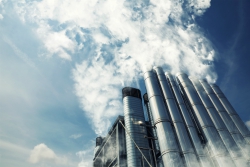Novel nanomaterials bring CCS efficiency to the next level
The core objective of INTERACT (INnovaTive Enzymes and polyionic-liquids based membRAnes as CO2 Capture Technology) was to surpass the energy efficiency and cost-effectiveness of existing capture processes. To this end, the team relied on enzymes to provide extraordinary fast biocatalysts and developed highly efficient nanomaterials called ‘polyionic liquids’ (PILs). The latter were used to create highly selective membranes for gas separation, which in turn were integrated in innovative technologies. ‘Current post-combustion processes, such as chemical scrubbing, face severe economic obstacles due to their high energy consumption,’ explains Prof. Dr Andrzej Gorak, coordinator of the project for TU Dortmund. ‘INTERACT provides a technological basis for advancing these processes: We notably enhanced the gas scrubbing process thanks to enzyme-catalysed solvent systems and innovative contacting equipment such as membrane contactors. Most importantly, we tried to exploit synergies between the high CO2 capture affinity of our materials and intensified technologies, whilst analysing performance based on a detailed techno-economic and life cycle assessment.’ INTERACT required extensive experimentations and detailed performance models for each technology, not only in the lab, but also at pilot scale. To identify suitable enzyme-solvent systems, for example, the team first performed activity tests with enzyme assays, whilst systems allowing for long-term stability were further investigated in terms of mass transfer improvements in dedicated lab-scale experiments in a wetted-wall column. Then, the most promising enzyme-solvent systems went through technical-scale absorption columns at different locations and with different diameters and packing heights. ‘The implementation of effective enzymes allows for the exploitation of solvents with lower absorption heat and higher CO2 capacity, which finally results in a significant reduction in the energy requirement of the chemical absorption process,’ Prof. Dr Gorak points out. The combination of carbonic anhydrase and an aqueous MDEA solution with the new enzyme showed an improvement in CO2 transfer by a factor of up to nine, and such a system can be applied to state-of-the-art scrubbing equipment. In the future, Prof. Dr Gorak is confident that even more improvements are possible. Untapped potential The project’s gas membranes based on PILs also showed potential for improving the energy efficiency of the CO2 capture process, although Prof. Dr Gorak says the economics still need to be improved: ‘The developed concept of a hybrid membrane contactor, which combines the application of both PILS and enzymes, is an interesting concept that allows for the exploitation of the synergies between these materials, but it needs to be investigated in more detail before a final assessment can be made.’ The most selective, porous and dense PILs proved to be competitive sorbents for use in adsorption processes as well as highly selective and active layers in thin film composite gas membrane processes. ‘Interestingly, one of the developed PIL materials, which was commercialised by one of the project partners, has aroused most interest so far in the field of electrochemical energy storage systems as a component of gel/polymer based electrolytes. It might help improve energy storage systems and the use of renewable energy,’ says Prof. Dr Gorak. Prof. Dr Gorak and his team made sure that, for each of the newly developed technologies, suitable process concepts were made available to exploit potential benefits while taking into account potential restrictions. These concepts were all evaluated under an industrial CO2 emission scenario. Detailed techno-economic and environmental evaluations showed that INTERACT technologies not only have the potential to significantly reduce the environmental impact of coal-fired power plants and other CO2 emitting processes, but also outperform state-of-the-art amine scrubbing process. In the future, Prof. Dr Gorak foresees applications beyond efficient CO2 capture from power plant flue gas. These include cement flue gas and biogas treatment: ‘Applying our technologies to produce “Renewable natural gas” (RNG) would give a push to more sustainable transportation fuels. There is an important potential in this sector where relatively large biogas infrastructures already exist. Moreover, RNG is a “drop in” fuel that can also be used as a diesel replacer for shipping and high-horsepower vehicles where few low carbon alternatives exist.’ One thing is certain: the project’s materials will certainly keep getting talked about over the years to come.
Keywords
INTERACT, enzymes, CCS, carbon capture, nanomaterials, polyionic liquid, amine scrubbing, enzyme-solvent, PILs, sorbent, flue gas, renewable natural gas

